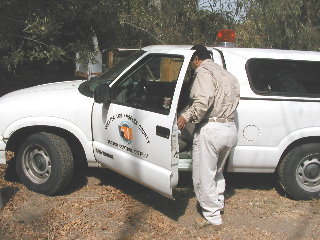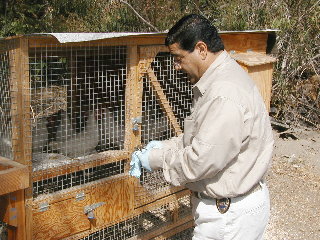






3853 Atlantic Ave.
|
Click here |
West Nile Gives Researchers New Data To Ponder
(October 16, 2004) -- This year's arrival of the The Greater L.A. County Vector Control District (GLACVCD) maintains a flock of "sentinel chickens" near the LB Animal Shelter -- a smart location, not far from the San Gabriel River, El Dorado Park and LB's Nature Center. It's one of many "sentinel chicken" flocks in the LB area and statewide.
The reasoning is simple: mosquitoes bite chickens and blood tests can reveal WNV and other serious mosquito-borne infections.
By late spring and early summer, LB residents began noticing dead crows in large numbers...even before some "sentinel chickens" began showing up as infected. Researchers also took notice.
In August, the Centers for Disease Control published a scholarly article in Emerging Infectious Diseases, ...In urban Los Angeles, sentinel chickens did not seroconvert [blood test shows positive antibodies] to WNV during 2003, despite being situated near recoveries of (The full article can be viewed at: West Nile Virus in CA.)
Disturbing data are also coming to light from other U.S. WNV outbreaks. As reported in August by LBReport.com via Reuters, another article in Emerging Infectious Diseases reported that for some people, recovery from a West Nile virus infection can take over a year, especially for older adults...with physical, cognitive and functional impairments sometimes lasting more than 18 months after the initial illness. (See: Reuters: West Nile Symptoms Can Last a Year or More.)
And in September, LBReport.com reported via Reuters that a study in a Annals of Internal Medicine indicates that for some people, West Nile fever is not just a three to six day illness with limited symptoms, but is a severe illness that can incapacitate people for a month or more. (See: Reuters: West Nile Fever More Severe Than Formerly Thought).
West Nile Virus produces no symptoms in roughly 80% of those bitten by infected mosquitoes, but has traditionally been believed to cause flu-like symptoms in about 20%. It can lead to encephalitis (brain swelling) or meningitis in about 1 in 150 people bitten by WNV infected mosquitoes.
As of October 15, California reported 750 human WNV cases statewide (with 617 positive WNV blood conversions of sentinel chickens).
LB has had 15 reported human WNV cases, including one death (in ELB on Aug. 9). Statewide, there have been 20 deaths...including a third reported in OC -- a 70 year old man who developed encephalitis and died in September (confirmed by CA's Dept. of Health Services on October 14).
As of October 15, L.A. County reported 300 WNV cases; OC had 59. Statewide, 74 WNV cases were first detected in asymptomatic persons through blood bank screening...and 11 later became symptomatic. Of the 687 WNV cases with symptoms, 254 are West Nile fever cases, 205 are West Nile neuroinvasive disease (encephalitis or meningitis) and 228 are of unknown status.
Health officials say cooler temperatures have produced somewhat reduced mosquito counts, but continue to urge residents to take mosquito precautions (long sleeves, DEET, etc.)
Related coverage:
LBReport.com collected West Nile Virus coverage
Contact us: mail@LBReport.com |
 On October 12, we spotted GLACVCD Vector Ecologist Saeed Tabatabaeepour arriving to tend to a flock of sentinel chickens not far from the Animal Shelter.
On October 12, we spotted GLACVCD Vector Ecologist Saeed Tabatabaeepour arriving to tend to a flock of sentinel chickens not far from the Animal Shelter. Mr. Tabatabaeepour gave the chickens fresh water and food and checked their general condition. The chickens weren't scheduled to have their blood drawn this day.
Mr. Tabatabaeepour gave the chickens fresh water and food and checked their general condition. The chickens weren't scheduled to have their blood drawn this day.